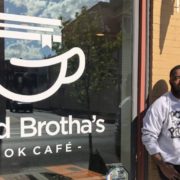“When you see a Black man doing good things in the community, you call him a good brotha,” Stefan Hawkins explained. “It’s a term of endearment.”
— Maddie Conley, The Burg
This is how Hawkins chose the name for his new coffee shop coming in November to Midtown Harrisburg—Good Brotha’s Book Café.
The café will be the 30-year-old entrepreneur’s second business venture along with his fiancé Laquana Barber, their first being House of Vegans restaurant in Midtown.
“We were the first Black-owned vegan restaurant in Harrisburg, and now we will be the first Black-owned coffee shop in Harrisburg,” Hawkins said. “After I saw the success of House of Vegans and how the community got behind us, I was like, I can get into this entrepreneur thing.”
— Credits
Featured Image, Owner Stefan Hawkins stands in front of what will be Good Brotha’s Book Café in Midtown come November
Full article @ The Burg
— Related
Harrisburg (/ˈhærɪsbɜːrɡ/ HARR-iss-burg; Pennsylvania German: Harrisbarrig) is the capital city of the Commonwealth of Pennsylvania in the United States, and the county seat of Dauphin County. With a population of 49,271, it is the 13th largest city in the Commonwealth. According to 2018 estimates of the Census Bureau, the population is 51.8% Black or African American, 22.6% White, 21.8% Latino, 5.4% Asian, and 0.4% Native American while 3.9% identify as two or more races. It lies on the east bank of the Susquehanna River, 107 miles (172 km) west of Philadelphia. Harrisburg is the anchor of the Harrisburg metropolitan area, which had a 2019 estimated population of 577,941, making it the fourth most populous metropolitan area in Pennsylvania and 96th most populous in the United States. It is the second-largest city in the multi-polar region known as the Lower Susquehanna Valley, comprising the Harrisburg, Lancaster and York metropolitan areas.
Harrisburg played a notable role in American history during the Westward Migration, the American Civil War and the Industrial Revolution. During part of the 19th century, the building of the Pennsylvania Canal, and later the Pennsylvania Railroad, allowed Harrisburg to become one of the most industrialized cities in the Northeastern United States. The U.S. Navy ship USS Harrisburg, which served from 1918 to 1919 at the end of World War I, was named in honor of the city. In the mid-to-late 20th century, the city’s economic fortunes fluctuated with its major industries consisting of government, heavy manufacturing, agriculture, and food services (nearby Hershey is home of the chocolate maker, located just 10 miles (16 km) east).
As of the 2010 census, the city was 52.4% Black or African American, 30.7% White, 3.5% Asian, 0.5% Native American, 0.1% Native Hawaiian, and 5.2% were two or more races. 18.0% of the population were of Hispanic or Latino ancestry.
The six largest ethnic groups in the city are: African American (52.4%), German (15.0%), Irish (6.5%), Italian (3.3%), English (2.4%), and Dutch (1.0%). While the metropolitan area is approximately 15% German-American, 11.4% are Irish-American and 9.6% English-American. Harrisburg has one of the largest Pennsylvania Dutch communities in the nation, and also has the nation’s ninth-largest Swedish-American communities in the nation.
Source – Harrisburg, Pennsylvania (Updated: 04 October 2020) Wikipedia. Available at https://en.wikipedia.org/wiki/Harrisburg,_Pennsylvania, (Accessed: 07 October 2020)

